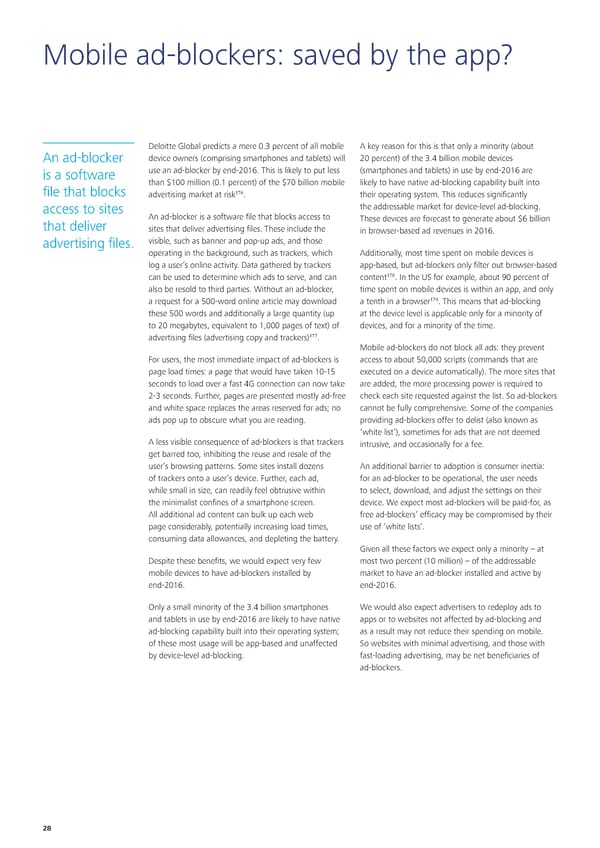Mobile ad-blockers: saved by the app? Deloitte Global predicts a mere 0.3 percent of all mobile A key reason for this is that only a minority (about An ad-blocker device owners (comprising smartphones and tablets) will 20 percent) of the 3.4 billion mobile devices is a software use an ad-blocker by end-2016. This is likely to put less (smartphones and tablets) in use by end-2016 are than $100 million (0.1 percent) of the $70 billion mobile likely to have native ad-blocking capability built into file that blocks 176 advertising market at risk . their operating system. This reduces significantly access to sites the addressable market for device-level ad-blocking. that deliver An ad-blocker is a software file that blocks access to These devices are forecast to generate about $6 billion sites that deliver advertising files. These include the in browser-based ad revenues in 2016. advertising files. visible, such as banner and pop-up ads, and those operating in the background, such as trackers, which Additionally, most time spent on mobile devices is log a user’s online activity. Data gathered by trackers app-based, but ad-blockers only filter out browser-based 178 can be used to determine which ads to serve, and can content . In the US for example, about 90 percent of also be resold to third parties. Without an ad-blocker, time spent on mobile devices is within an app, and only 179 a request for a 500-word online article may download a tenth in a browser . This means that ad-blocking these 500 words and additionally a large quantity (up at the device level is applicable only for a minority of to 20 megabytes, equivalent to 1,000 pages of text) of devices, and for a minority of the time. 177 advertising files (advertising copy and trackers) . Mobile ad-blockers do not block all ads: they prevent For users, the most immediate impact of ad-blockers is access to about 50,000 scripts (commands that are page load times: a page that would have taken 10-15 executed on a device automatically). The more sites that seconds to load over a fast 4G connection can now take are added, the more processing power is required to 2-3 seconds. Further, pages are presented mostly ad-free check each site requested against the list. So ad-blockers and white space replaces the areas reserved for ads; no cannot be fully comprehensive. Some of the companies ads pop up to obscure what you are reading. providing ad-blockers offer to delist (also known as ‘white list’), sometimes for ads that are not deemed A less visible consequence of ad-blockers is that trackers intrusive, and occasionally for a fee. get barred too, inhibiting the reuse and resale of the user’s browsing patterns. Some sites install dozens An additional barrier to adoption is consumer inertia: of trackers onto a user’s device. Further, each ad, for an ad-blocker to be operational, the user needs while small in size, can readily feel obtrusive within to select, download, and adjust the settings on their the minimalist confines of a smartphone screen. device. We expect most ad-blockers will be paid-for, as All additional ad content can bulk up each web free ad-blockers’ efficacy may be compromised by their page considerably, potentially increasing load times, use of ‘white lists’. consuming data allowances, and depleting the battery. Given all these factors we expect only a minority – at Despite these benefits, we would expect very few most two percent (10 million) – of the addressable mobile devices to have ad-blockers installed by market to have an ad-blocker installed and active by end-2016. end-2016. Only a small minority of the 3.4 billion smartphones We would also expect advertisers to redeploy ads to and tablets in use by end-2016 are likely to have native apps or to websites not affected by ad-blocking and ad-blocking capability built into their operating system; as a result may not reduce their spending on mobile. of these most usage will be app-based and unaffected So websites with minimal advertising, and those with by device-level ad-blocking. fast-loading advertising, may be net beneficiaries of ad-blockers. 28
 Technology, Media & Telecommunications Predictions Page 34 Page 36
Technology, Media & Telecommunications Predictions Page 34 Page 36